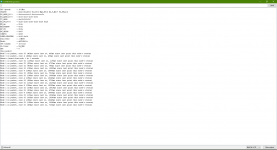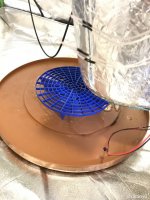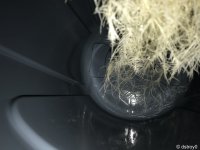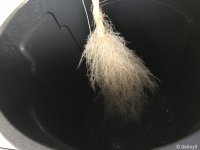You are using an out of date browser. It may not display this or other websites correctly.
You should upgrade or use an alternative browser.
You should upgrade or use an alternative browser.
Growing stuff and doing things
- Thread starter dstroy0
- Start date
dstroy0
Zeroes and Ones
Soo... I'm having problems still 
I can fix the mg def, but I don’t know enough about plants or nutrients to say that will also fix the p def or whatever else.
I CAN feed more, but they stopped eating every time I tried 321 at more than 1.6EC.
I was still using greenleafnutrients calcium nitrate, so I ordered some jacks calcium nitrate, that gets here soon.
I read a couple people under leds saying they had to add twice the amount of epsom to bring mg ppm up.
I need a fresh set of eyes, thoughts? Thanks in advance for your time.






I can fix the mg def, but I don’t know enough about plants or nutrients to say that will also fix the p def or whatever else.
I CAN feed more, but they stopped eating every time I tried 321 at more than 1.6EC.
I was still using greenleafnutrients calcium nitrate, so I ordered some jacks calcium nitrate, that gets here soon.
I read a couple people under leds saying they had to add twice the amount of epsom to bring mg ppm up.
I need a fresh set of eyes, thoughts? Thanks in advance for your time.






Bubby's n da lab
Blue Collar Beans
Soo... I'm having problems still
I can fix the mg def, but I don’t know enough about plants or nutrients to say that will also fix the p def or whatever else.
I CAN feed more, but they stopped eating every time I tried 321 at more than 1.6EC.
I was still using greenleafnutrients calcium nitrate, so I ordered some jacks calcium nitrate, that gets here soon.
I read a couple people under leds saying they had to add twice the amount of epsom to bring mg ppm up.
I need a fresh set of eyes, thoughts? Thanks in advance for your time.
View attachment 61614View attachment 61615View attachment 61616View attachment 61617View attachment 61618
sorry for not knowing
but what's your water source
ro
tap
well?
dstroy0
Zeroes and Ones
sorry for not knowing
but what's your water source
ro
tap
well?
RO
Bubby's n da lab
Blue Collar Beans
dstroy0
Zeroes and Ones
by the look of the fans
her feet look wet
overwatering? I can try increasing the time between feedings
Bubby's n da lab
Blue Collar Beans
yupoverwatering? I can try increasing the time between feedings
are your petioles soft or mushy
Last edited:
dstroy0
Zeroes and Ones
yup
are your petioles soft or mushy
no, they snap still. Roots look good, clean and white, no brown tips. They’re not sitting in water, if that makes a difference, they hang in air. I can try increasing the drainage hole size in the bottom of the pots too. I’ll get some pictures. Thank you
I feel I notice a difference between the anhydrous cal nit and ag grade / fertilome. It shows in th calcs too anhydrous had a slight bump in N with larger bump in Ca ppm for same wt./vol. Curious of differences in jacks vs. greenleaf?
A page or so back I thought maybe Ca with the inter vein coloration but idk those purple petiols and the way the blades are intersecting at the petiole -so narrow and no hub (idk the right term), says p/k issue.
Long way to say idk.
A page or so back I thought maybe Ca with the inter vein coloration but idk those purple petiols and the way the blades are intersecting at the petiole -so narrow and no hub (idk the right term), says p/k issue.
Long way to say idk.
Buck5050
Underground Chucker
On the surface the Jacks cal-nit is far superior than Greenleafs head to head. I opened the bag and I was like "sh#t!, What have I been using this whole time, these guys really have their stuff together"Curious of differences in jacks vs. greenleaf?
dstroy0
Zeroes and Ones
I'm making RSO today, just decarbed the last of my trim, about 1.5lb starting material.
I'm doing a quick extract this time where I put the decarbed plant material in the still, then add everclear and cook it for 45 minutes or so, readding everclear to the still to keep it at a constant level. Then I filter out plant material and finally distill out the alcohol leaving the oil behind.
I'm doing a quick extract this time where I put the decarbed plant material in the still, then add everclear and cook it for 45 minutes or so, readding everclear to the still to keep it at a constant level. Then I filter out plant material and finally distill out the alcohol leaving the oil behind.
Buck5050
Underground Chucker
Moving from MC 2-part where my mix had the cal-nit at 2.5 gr/gal to using it at 2 gr/gal definitely through the plants off into a deficiency. The sad part is it took me a second to realize what I changed...proven fact in my garden If using LEDs a bit more cal-nit isn't a bad idea.I don't know... but as soon as I get jacks calnit I'm going to change the res and do 321.
dstroy0
Zeroes and Ones

porting to new hardware and platforms, experimenting with new things
C++:
#include <Wire.h>
#include "PCA9685.h"
#include "Adafruit_MCP23017.h"
#include "printf.h"
#include <RF24.h>
#include <RF24Network.h>
#include <rf24network_payloads.h>
#define SERIAL_0_BAUD 115200
#define I2C_CLOCK_SPEED 1000000
#define PCA9685_PWM_FREQ 1000
const uint8_t mcu_bus_power_enable_pin = 2;
const uint8_t rx_status_led_pin = 3;
uint16_t bus_voltage_input = 0;
/*RF24 radio setup*/
RF24 radio(40, 9); // nRF24L01 teensy 4.1 pins CE 40 CSN 9
RF24Network network(radio); // use radio object on this network
const uint16_t this_node = 00; // Address of our node in Octal format ( 04,031, etc)
const uint16_t transmit_node_one = 01; // Address of the other node in Octal format
const uint16_t transmit_node_two = 02; // Address of the other node in Octal format
const uint16_t transmit_node_three = 03;
//number of nodes in network, including this node.
const uint16_t NUM_NODES = 4;
env_sensor_payload rx1_payload, rx2_payload; //rf24network_payloads.h
outlet_switch_payload rx3_payload; //rf24network_payloads.h
//rf24 buffer
uint8_t dataBuffer[MAX_PAYLOAD_SIZE]; //MAX_PAYLOAD_SIZE is defined in RF24Network_config.h
//rf24 status led
unsigned long led_toggle_timer = 0;
unsigned long led_toggle_on_time_msec = 15UL;
PCA9685 pwmController; // 1khz pwm source
Adafruit_MCP23017 mcp; // i2c GPIO expander
void pin_setup() {
pinMode(mcu_bus_power_enable_pin, OUTPUT);
digitalWrite(mcu_bus_power_enable_pin, HIGH);
pinMode(rx_status_led_pin, OUTPUT);
digitalWrite(rx_status_led_pin, HIGH);
pinMode(A0, INPUT);
}
void init_devices() {
//USB serial
Serial.begin(SERIAL_0_BAUD);
//set i2c clock speed
Wire.setClock(I2C_CLOCK_SPEED);
//start mcp object at address 0
mcp.begin(&Wire); // use default address 0
//init mcp pins
for (int i = 0; i < 16; i++) {
mcp.pinMode(i, OUTPUT);
mcp.digitalWrite(i, LOW);
}
//pca9685 setup
pwmController.resetDevices(); // Resets all PCA9685 devices on i2c line
pwmController.init(); // Initializes module using default totem-pole driver mode, and default disabled phase balancer
pwmController.setPWMFrequency(PCA9685_PWM_FREQ); // Set PWM freq (default is 200Hz, supports 24Hz to 1526Hz)
if (!radio.begin()) {
Serial.println(F("RF24 radio hardware not responding, check connections!"));
//implement sensorless routine here
while (1) {
// hold in infinite loop
}
}
network.begin(/*channel*/ 90, /*node address*/ this_node);
printf_begin(); // Used to enable printf on AVR devices
radio.printDetails(); // requires printf support
Serial.print(F("this_node=")); Serial.println(this_node);
}
bool payload_switch(uint16_t node, RF24NetworkHeader header, uint16_t payloadSize) {
switch (node) {
case 1: {
if (payloadSize == sizeof(rx1_payload)) {
network.read(header, &rx1_payload, sizeof(rx1_payload)); // Get the data
return true;
} else {
//garbage can
network.read(header, &dataBuffer, payloadSize); // Get the data
return false;
}
break;
}
case 2: {
if (payloadSize == sizeof(rx2_payload)) {
network.read(header, &rx2_payload, sizeof(rx2_payload)); // Get the data
return true;
} else {
//garbage can
network.read(header, &dataBuffer, payloadSize); // Get the data
return false;
}
break;
}
case 3: {
if (payloadSize == sizeof(rx3_payload)) {
network.read(header, &rx3_payload, sizeof(rx3_payload)); // Get the data
return true;
} else {
//garbage can
network.read(header, &dataBuffer, payloadSize); // Get the data
return false;
}
break;
}
default: {
Serial.print(F("Unknown node: \"")); Serial.print(node); Serial.println(F("\""));
return false;
break;
}
}
return false;
}
uint32_t try_commit_payload_to_memory(uint16_t node, RF24NetworkHeader header, uint16_t payloadSize, uint32_t timeBetweenPackets) {
digitalWrite(rx_status_led_pin, HIGH);
led_toggle_timer = millis();
static uint32_t time_since_print[NUM_NODES + 1] = {0};
uint32_t elapsed_millis = millis() - timeBetweenPackets;
uint16_t t_node = 0;
//unknown node print
if (node > NUM_NODES-1) {
t_node = NUM_NODES;
}
else {
t_node = node;
}
uint32_t elapsed_millis_since_print = millis() - time_since_print[t_node];
if (elapsed_millis > 300UL || elapsed_millis_since_print >= 10000UL) {
Serial.print(F("Node ")); Serial.print(node); Serial.print(F(" rx packet, size ")); Serial.print(payloadSize);
Serial.print(F(" (")); Serial.print(elapsed_millis); Serial.print(F("ms since last rx, ")); Serial.print(elapsed_millis_since_print);
Serial.println(F("ms since last print this node's status)"));
time_since_print[t_node] = millis();
}
timeBetweenPackets = millis();
//this is where what is received gets copied into memory
bool ok = payload_switch(node, header, payloadSize);
if (ok == false) {
Serial.print(F("Packet length mismatch Node ")); Serial.println(node);
}
return timeBetweenPackets;
}
void rx_handler(RF24NetworkHeader header, uint16_t payloadSize) {
uint16_t node = header.from_node;
static uint32_t timeBetweenPackets[NUM_NODES + 1] = {0};
if (node <= (NUM_NODES - 1)) {
timeBetweenPackets[node] = try_commit_payload_to_memory(node, header, payloadSize, timeBetweenPackets[node]);
}
else {
//unknown node packet timer
timeBetweenPackets[NUM_NODES] = try_commit_payload_to_memory(node, header, payloadSize, timeBetweenPackets[node]);
}
}
void network_handler() {
//how long since we received a packet from N node timer
static uint32_t keep_alive[NUM_NODES + 1] = {0};
//timer for printing status
static uint32_t keep_alive_print_timer[NUM_NODES + 1] = {0};
//turn off status led if it's time
if ((millis() - led_toggle_timer) >= led_toggle_on_time_msec) {
digitalWrite(rx_status_led_pin, LOW);
}
network.update(); // Check the network regularly
while (network.available()) { // Is there anything ready for us?
RF24NetworkHeader header; // If so, grab it and print it out
uint16_t payloadSize = network.peek(header); // Use peek() to get the size of the payload
//sort the mail
rx_handler(header, payloadSize);
//if the transmitting node is unknown (higher address) keep track of how often we get packets (same timer for all unknown nodes)
if (header.from_node >= NUM_NODES) {
keep_alive[NUM_NODES] = millis(); //the last element in keep_alive is the unknown node timer
}
else {
keep_alive[header.from_node] = millis(); //we know about all these nodes
}
}
//this "see if we have anything to print" doesn't need to happen every call, probably 50-500ms would be more than enough
for (int i = 1; i < NUM_NODES; i++) {
uint32_t elapsed_time = millis() - keep_alive[i];
if (elapsed_time >= 1000UL) {
if (millis() - keep_alive_print_timer[i] >= 1000UL) {
uint32_t temp = elapsed_time / 1000;
Serial.print(F("Haven't heard from node ")); Serial.print(i); Serial.print(F(" in ")); Serial.print(temp); Serial.println(F(" seconds"));
keep_alive_print_timer[i] = millis();
}
}
}
}
//pwm demo
void do_pwm_things() {
//using some leds for testing
static int pwm_val = 0;
static bool fade_up = true;
pwmController.setChannelPWM(0, pwm_val); //pwm_val = 0-4095
pwmController.setChannelPWM(1, pwm_val); //pwm_val = 0-4095
pwmController.setChannelPWM(2, pwm_val); //pwm_val = 0-4095
pwmController.setChannelPWM(3, pwm_val); //pwm_val = 0-4095
if (fade_up == true && pwm_val <= 4095) {
pwm_val++;
if (pwm_val > 4095) {
pwm_val = 4096; //will immediately be caught by next if statement and -- to 4095
fade_up = false;
}
}
if (fade_up == false && pwm_val >= 1) {
pwm_val--;
if (pwm_val < 1) {
pwm_val = 0; //gets set next run through loop()
fade_up = true;
}
}
}
//mcp demo
void mcp_demo() {
static unsigned long timer = 0;
static bool toggle = false;
if ((millis() - timer) >= 20UL) {
for (int i = 0; i < 4; i++) {
if (toggle == false) {
mcp.digitalWrite(i, HIGH);
} else {
mcp.digitalWrite(i, LOW);
}
}
if (toggle == false) {
toggle = true;
} else {
toggle = false;
}
timer = millis();
}
}
void setup(void) {
pin_setup();
init_devices();
}
void loop(void) {
network_handler(); //semi-production network handler
do_pwm_things(); //pca9685 1khz pwm demo
mcp_demo(); //mcp i2c GPIO expander demo (blink port A 1-4)
//A0 is connected to 3.3v bus power through a voltage divider, the idea here is to disconnect I2C and SPI if we lose bus power
//should be disconnected using analog switches CD4066? I think 400ma is more than enough current handling capability for my i2c and SPI
static uint32_t bus_power_sense_timer = 0;
if (millis() - bus_power_sense_timer >= 10UL) {
bus_voltage_input = analogRead(A0);
}
}library for my network payloads makes it a little easier to change what's in there or add new payloads, I haven't settled on a naming convention yet, can you tell? lol
C++:
#ifndef _network_payloads_H_
#define _network_payloads_H_
#include "Arduino.h"
#define PAYLOAD_VERSION 1
class env_sensor_payload
{
public:
uint16_t version = PAYLOAD_VERSION;
float temperature = 0.0;
float humidity = 0.0;
uint16_t co2 = 0;
float leaf_temp[4] = {0.0, 0.0, 0.0, 0.0};
float vpd[5] = {0.0, 0.0, 0.0, 0.0, 0.0};
};
class outlet_switch_payload
{
public:
uint16_t version = PAYLOAD_VERSION;
bool outlet_on = false;
};
#endifJewels
Tilts at Tables
the look
burdened , oppressed. I was leaning that way also, Bub, knowing fullwell the plant was bare root. It has the look.
Is it just carrying a grudge on the old growth? ,,, abandoned by mobile nutrients?
The top is erect and praying.
dstroy0
Zeroes and Ones
burdened , oppressed. I was leaning that way also, Bub, knowing fullwell the plant was bare root. It has the look.
Is it just carrying a grudge on the old growth? ,,, abandoned by mobile nutrients?
The top is erect and praying.
I was using greenleaf nutrients calcium nitrate with my jacks part a. I switched to jacks calcium nitrate two weeks ago and I can feed them full strength and they eat, that was not happening before.
I’m leaning towards there is too much ammonium in the GLN calnit I have. Ammonium toxicity makes sense, my mom plants have grown about 6” in two weeks after flushing out all the old stuff. I haven’t had to do weekly maintenance on them in a while they just sat there not growing like an unfertilized houseplant, until I switched up the calcium nitrate source. If greenleafnutrients were mixing calcium nitrate with calcium ammonium nitrate to get a certain ammonium % and it wasn’t blended properly.... I think that’s what happened.
Anyways, plants are eating now and it’s going to legit be an entire year between harvests for me.
Jewels
Tilts at Tables
Glad you got her figured. Funny, how they can grow like rampant weeds ,,, and then full stop.they just sat there not growing
,,, the asshole in me almost suggested
" have you tried turning on a light ?" ?
,,, cause indeed- they looked like they were just sitting there.
My brand of humour is slightly offensive in person, and often translates worse as written word.
Impetuous cads, thinking they could pull one over on Destroy.
I freely admit that I do not a have a complete understanding of all the chemistry involved,,,were mixing calcium nitrate with calcium ammonium nitrate to get a certain ammonium % and it wasn’t blended properly....
,,, so I will start with what I DO know.
I have very hard tapwater.
No urea involved, although this product somehow " busts up " the liquid rock, and makes it drinkable for the plants.

Like I say, I dont understand the exact action, but consider,,,
If you were accidentally use this product with your RO supply,,,could you level the playing field ( reset ) with the addition of some hard water ?
At any rate, you deserve a fine harvest. Keep up the good work.






